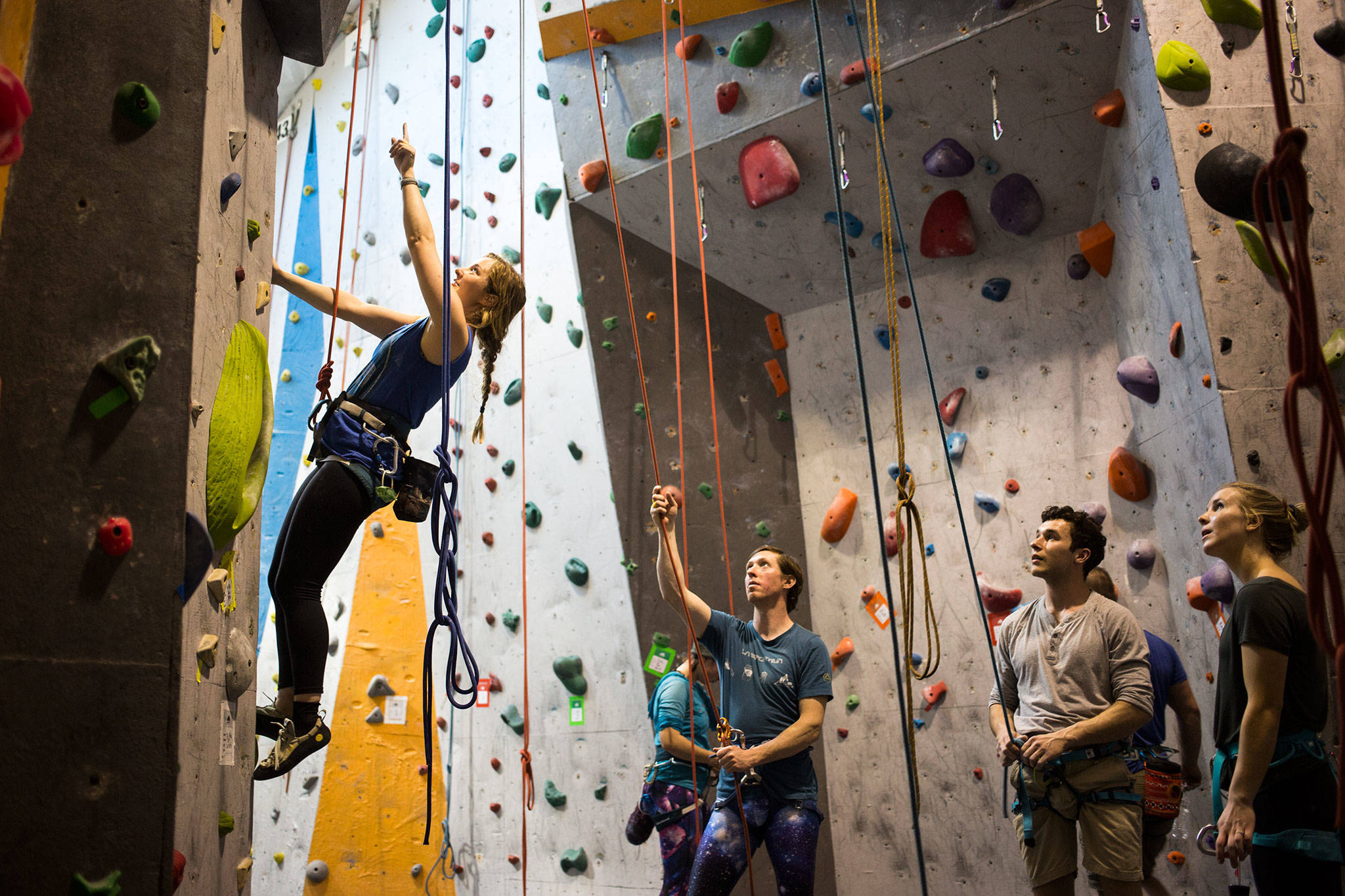I padded my hands with climbing chalk three times, but my palms and fingertips were still sweaty with anticipation.
Towering above me was one of the climbing walls at Summit Everett on Rucker Avenue. I didn’t know how tall it was. I’m deathly afraid of heights and had never been rock climbing, so it may as well have been Mount Everest.
Little did I know reaching the top was going to be one of the most satisfying experiences of my life.
Summit Everett, which opened in 2016, has three main attractions: top rope climbing, auto belay and bouldering.
Top rope climbing requires a belayer, who stays on the ground and keeps a watchful eye on climbers’ progress and catches them if they fall. Auto belays control the slack of a rope as a climber ascends or descends without the need for a belayer. Bouldering is climbing without a rope on a shorter wall with a padded flooring system to cushion falls.
I signed up for an all-access pass for $40, which included rental gear and one hour of staff instruction and climbing. Joining me were my sister, Kelly Thompson, and her two friends Jake Vissering of Seattle and Brent Eaton of Everett.
They all had years of climbing experience. I was still nervous, even with them by my side.
I tugged at the rope tied to my harness. It looped from the padded floor to the very top near the ceiling. My belayer, volunteer instructor Janelle Schank, waited for my signal to begin.
“On belay?” I asked.
“Belay on,” she replied.
I took a deep breath and gave the final command.
“Climbing.”
“Climb.”
The first few handholds were easy. I felt like a speed climber, not a rookie. I’d be to the top in no time if I stayed at this pace.
I was about half way up when Kelly, watching from below, reminded me that I was supposed to use only the white handholds. In my rush to finish my first climb, I’d completely forgotten one of the basic climbing procedures.
Routes, varying in difficulty, are designated by colored handholds and grips, which zig and zag up the wall. They come in different shapes and sizes, from large jug-like grips to small holds for only the fingertips or toes. Objects that protrude from the wall, known as “volumes,” are free to use on any route to help climbers progress.
Each transition — the movement from one grip to the next — requires quick thought and calculation. Stay in one spot for too long and fatigue sets in.
I became painfully aware of how high I was when I looked down at Kelly. It was like my insides were screaming for me to climb down. I realized I was stuck with the white route — the harder of the two on this particular wall — because it was the first handhold I had grabbed.
There was no time to waste. I shifted my hips, lifted my left foot to the next grip, then reached for another handhold set dauntingly far above me. I repeated the process, relying on every muscle in my body, until I finally reached the top.
I hung 30 feet high, the equivalent of a three-story building. My first of four climbs that day were complete. It was a huge relief.
My forearms were tense and I was out of breath. I rested and watched climbers of all ages around the gym expertly maneuver the walls — each of them with their own shapes and contortions to replicate a real cliff or mountain face — trying to pick up on their techniques.
My sister, her friends and my belayer gave me climbing tips and critiqued my movements.
Schank said it’s easy for newcomers — and especially guys — to try and muscle their way up the wall using mostly upper-body strength. But it’s nothing like climbing a ladder.
Some of the tips they shared with me:
Keeping your arms straight lessens the strain on your muscles and lowers your chance of running out of steam.
The legs are an important source of strength on the wall. The more efficient you are with all of your limbs, the better you become.
If it’s your first climb, plan to go with friends who have done it before so you can watch their technique.
I hit an internal crossroad on my last climb about three-fourths of the way up. I needed my right foot and right hand to move at the same time to complete the second to last transition. Even though I was attached to a rope and perfectly safe, it felt like a monumental risk.
I silenced my inner doubt, took a deep breath and went for it. I made it — surprising myself by how fluid the motion felt.
The final handhold and foothold seemed miles away. My energy was depleted and my stomach churned from my persistent fear of heights. I felt accomplished having pushed myself to that point, so I signaled Schank to bring me down.
I’m not beating myself up about it. There’s always next time.
If you go
Summit Everett, 2820 Rucker Ave., Everett, offers classes, memberships, youth climbing schools and group reservations. Hours are 11 a.m. to 10 p.m. Monday through Friday, 10 a.m. to 9 p.m. Saturday and 10 a.m. to 7 p.m. Sunday. Day passes are $16 for ages 14 and older or $13 for ages 13 and younger; all-access passes are $40 and a 10-visit punch pass is $140.
More at www.summiteverett.com.
Talk to us
> Give us your news tips.
> Send us a letter to the editor.
> More Herald contact information.


























